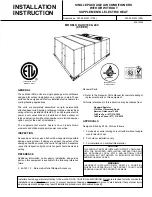
19
CAPACITY CONTROL
Hot Gas Bypass
The purpose of the hot gas bypass refrigerant circuit is to
maintain evaporator temperature above freezing (32
degrees), thus saving the compressor from failure and
controlling capacity. Compressor capacity modulation by
means of hot gas bypass is used where normal
compressor cycling or the use of cylinder unloading alone
may not be sufficient. This bypass valve is used on all
RCA units. It must be field adjusted. The bypass valve
opens at the recommended setting and can bypass up to
50% to the evaporator. Due to the reduced power
consumption at lower suction pressures, the hot gas
bypass valve should be adjusted to bypass at the minimum
suction pressure within the compressors operating limits.
Be sure the hot gas setting is lower than the unloading
pressure control when both are used (semi- hermetic). If
the pressure setting of the cylinder unloading is increased,
the hot gas bypass setting must also be increased.
In order to make field adjustments to this regulator, it may
require simulating a light load condition. Connect a
pressure gauge to the suction line and block the entering
air to the evaporator. Suction pressure will drop and the
valve should begin to open at approximately 62 PSIG. It
has a range of 6 PSIG and will be fully open at 56 PSIG.
The hot gas bypass valve will get warm to the touch when
the valve begins to open. To adjust, remove the cap and
turn the adjusting stem clockwise to reduce the setpoint
and counterclockwise to increase the setpoint. Allow 5
minutes between adjustments to allow the system to
stabilize.
SEQUENCE OF OPERATION
Control Sequence
Refer to typical wiring diagrams for these units.
The field supplied system switch is closed. The “R” circuit
from the transformer is fed through the system switch to
the coil of the blower motor contactor. This energizes the
coil and closes the contacts which brings power to the
blower motor.
From the low voltage terminal board “R” is connected to
the “G” by the closing of the system switch. “G” is a series
circuit through the compressor lockout thermostat. If the
outdoor temperature is above the setting of the
compressor lockout thermostat, “G” is connected to the “Y”
terminal and continues to the coil of the cooling relay. This
energizes the contacts of the cooling pilot relay which
energizes the hot gas bypass solenoid. Another set of
contacts from this relay apply power to the “A” terminal of
the low voltage terminal board. This energizes the coil of
the liquid line solenoid valve. In a parallel circuit power is
applied to the high pressure control, and the adjustable
time delay. The time delay begins when power is applied
to the timer.
After the time delay closes, the circuit continues through
the low pressure switch, and the compressor overload
protection module (if supplied). The coil of the compressor
contactor is now energized. At this time the coil of the
contactor for the condenser fans is fed through the low
ambient control switch (units with reheat use the variable
speed control). The contacts close and power is applied to
the compressor and fan motors.
On systems with semi-hermetic compressors, the
compressor contactor and condenser fan contactor(s) are
in a series circuit with the oil failure control, and the
optional phase monitor. The unloading pressure control will
energize and de-energize the unloader solenoid on the
compressor as needed.
Systems with hot gas reheat (optional), power is applied
from the reheat thermostat from “Y- H” to the reheat valve
relay. The reheat thermostat is to be set between 65-70
degrees F. When the outlet or leaving air drops below this
setting the thermostat contacts will close and energize the
reheat valve relay. The reheat refrigerant circuit is now
initiated.
It should be noted that the high pressure control has a
manual reset feature. The low pressure cutout is set at 60
PSIG and is automatic reset. Experience has indicated that
fast cycling on the low pressure control is due to low
refrigerant charge, dirty filters, dirty evaporator coil, loose
belts, or reduced air flow and will ruin contactor points and
compressors.
Operating Pressures and Temperatures
This information should only be used as a guide, due to
the diversity of applications and various conditions (wet
bulb and dry bulb) that may be present in the field; A
properly charged system will have varied suction and
discharge pressures depending on whether the unit is
equipped with unloading, hot gas reheat, or in hot gas
bypass. The head pressure will be controlled by the low
ambient control bringing the fan motors on to lower and
turning the fans off to raise the head pressure. The suction
pressures will vary up and down reacting to the outdoor
(WB) temperature and will depend on whether the unit is in
hot gas bypass or unloaded. The head pressure will vary
from 350-400 PSIG at average (85-95 degree DB) outdoor
temperatures.
The temperature difference between the return air (outside
temperature DB) and the supply air should be
approximately 30-40 degrees F at average entering (WB)
conditions. CFM must be correct. The sub-cooling should
be around 15 degrees at 75 degrees F and as low as 5
degrees at 105 degrees F. The superheat should be
approximately 18-20 degrees F. at the suction line in the
condensing unit.
Summary of Contents for RCA051
Page 8: ...8 DIMENSIONS...
Page 9: ...9 DIMENSIONS Continued...
Page 10: ...10 DIMENSIONS...
Page 11: ...11 DIMENSIONS Continued...
Page 14: ...14 TYPICAL FIELD WIRING DIAGRAM...
Page 17: ...17 FIELD WIRING DIAGRAM...
Page 24: ......
Page 26: ...26 NOTES...
Page 27: ...27 NOTES...
Page 28: ...28...










































